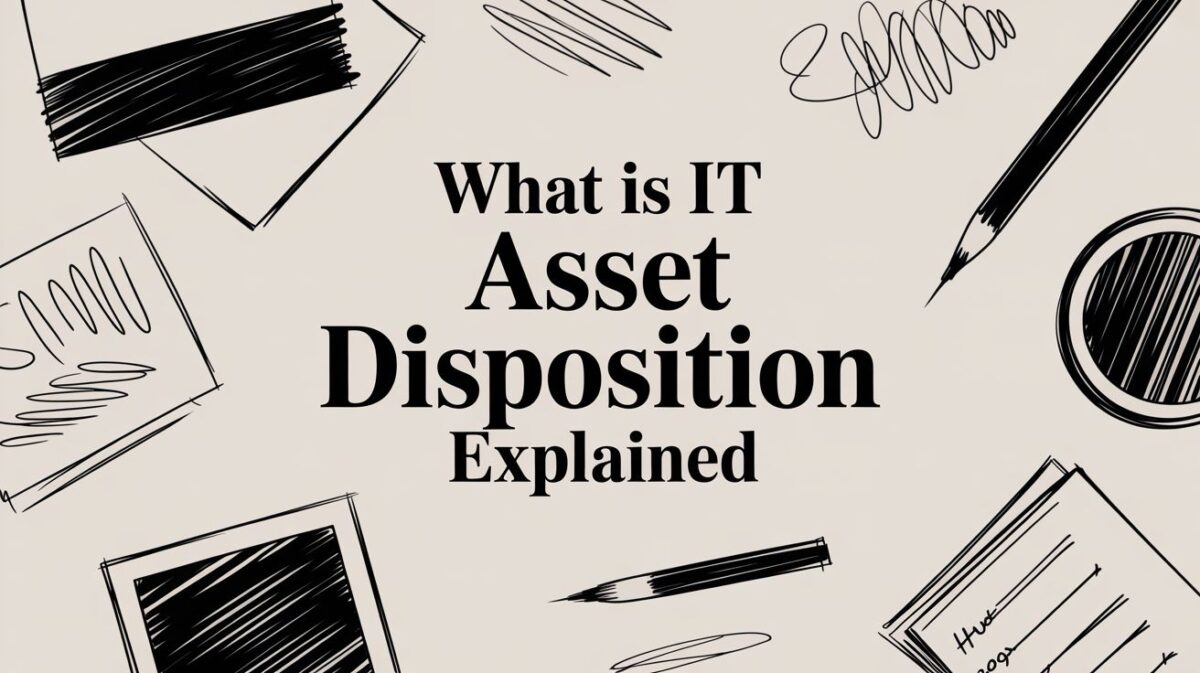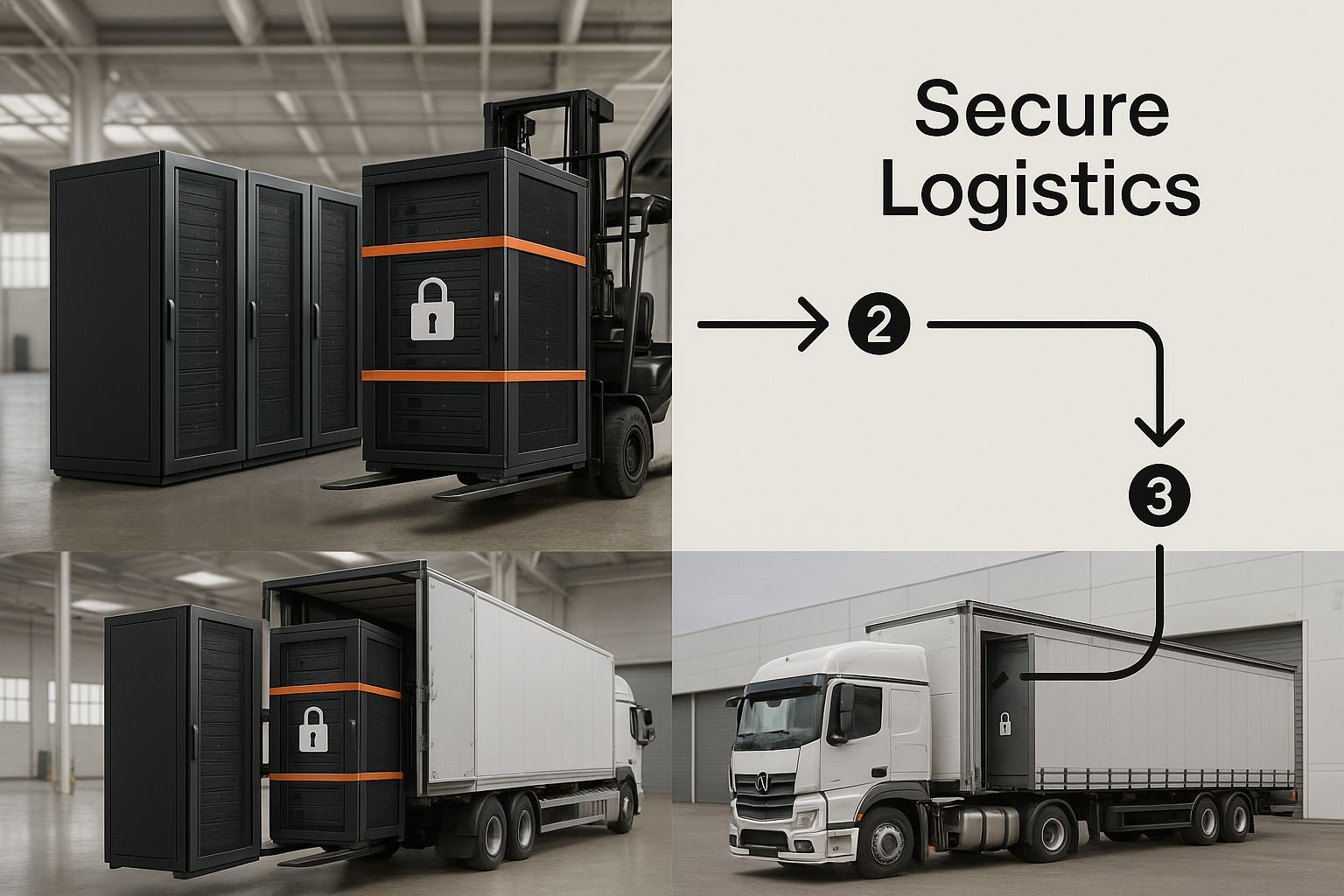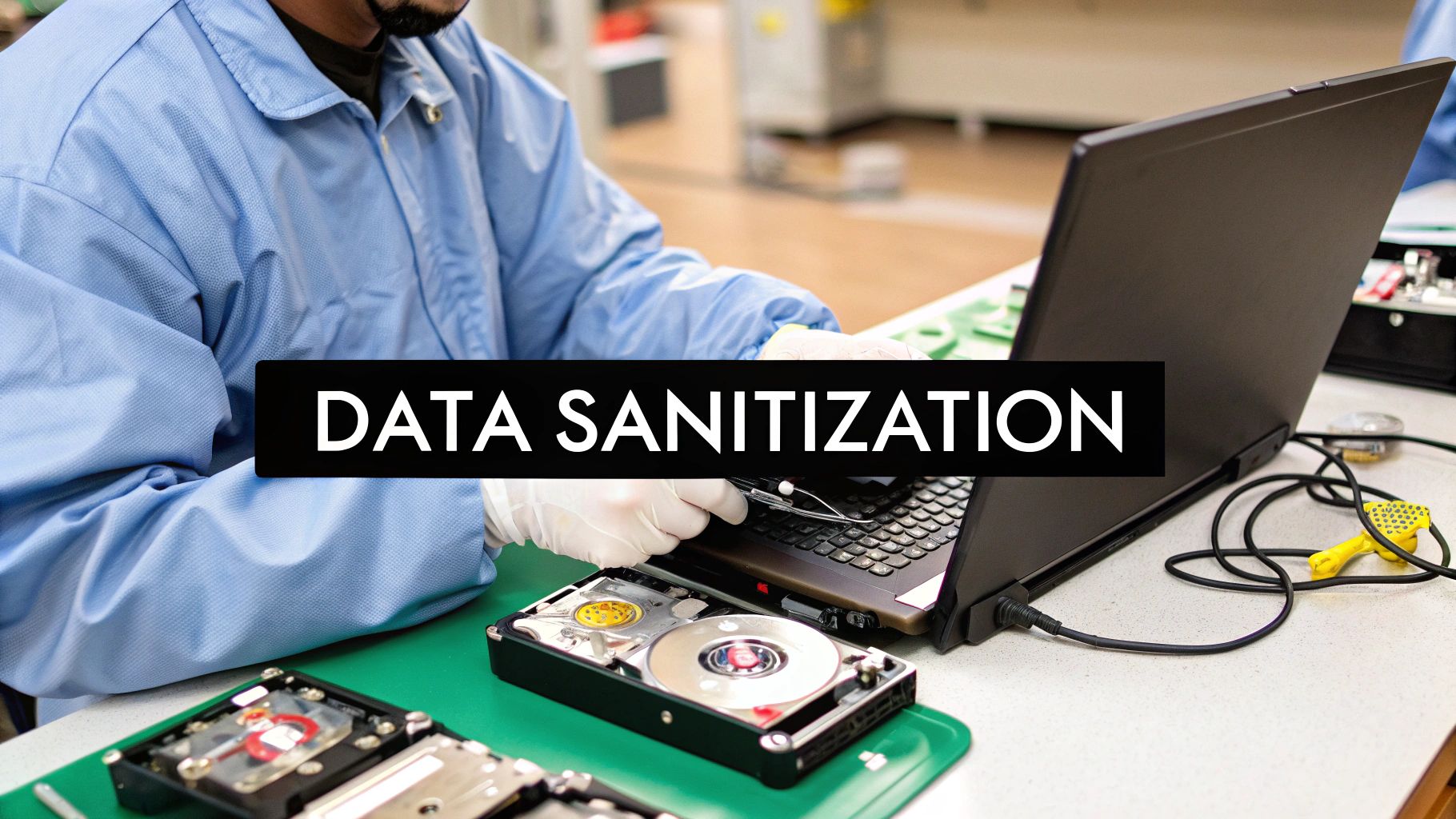What Is IT Asset Disposition Explained

At its heart, IT Asset Disposition (ITAD) is the business strategy for managing your company's technology at the end of its lifecycle. It's not just about disposal; it's a critical business function that demands airtight security, financial acumen, and unwavering regulatory compliance.
What Is IT Asset Disposition Really About?
When your servers, laptops, or networking gear reach their end-of-life, simply unplugging them is not an option. These devices are repositories of sensitive corporate data, often hold residual financial value, and are subject to stringent environmental regulations. Overlooking this reality exposes your business to significant risks, from costly data breaches and reputational damage to severe legal penalties.
This is where IT Asset Disposition, or ITAD, provides a structured, professional framework for managing these end-of-life challenges. A proper ITAD strategy is a comprehensive service built on three core pillars designed to protect your organization and enhance your bottom line.
The Three Pillars of a Modern ITAD Program
A successful ITAD program is not a one-off task but a multi-layered strategy. It balances security, value recovery, and corporate responsibility to transform a potential liability into a strategic advantage.
- Ironclad Data Security: This is the non-negotiable foundation of any professional ITAD service. A certified ITAD process ensures that every bit of data on your retired assets is permanently and verifiably destroyed, preventing catastrophic data leaks and safeguarding your company's reputation.
- Maximum Value Recovery: Obsolete technology is not always worthless. Your retired IT equipment often retains market value. The ITAD process involves meticulous testing, grading, and remarketing of functional assets on secondary markets, generating revenue to offset new technology expenditures.
- Guaranteed Environmental Compliance: E-waste management is a complex regulatory landscape. A certified ITAD partner guarantees that all non-functional hardware is recycled according to strict environmental standards, providing auditable documentation that supports your corporate sustainability goals.
A formal ITAD strategy is a business essential. It elevates your company from a reactive disposal model to a proactive system that secures data, recovers value, and ensures legal and environmental compliance.
The demand for these specialized services is expanding rapidly. The global ITAD market, valued at approximately USD 25.79 billion, is projected to reach USD 90.06 billion by 2034, driven by the increasing volume of e-waste and ever-tightening data security regulations.
To provide a clearer picture, here is a breakdown of what a comprehensive ITAD program entails.
Core Components of a Modern ITAD Program
| Component | Business Objective |
|---|---|
| Data Destruction | Guarantees complete erasure of sensitive information to prevent data breaches. |
| Asset Remarketing | Recovers financial value from functional equipment to offset new IT investments. |
| Certified Recycling | Ensures responsible disposal of e-waste in compliance with environmental laws. |
| Logistics & Decommissioning | Provides secure pickup, transport, and removal of assets from your facility. |
| Inventory & Reporting | Delivers detailed documentation and certificates for audit and compliance needs. |
Understanding these components is the first step toward building a program that is both secure and profitable. To see how these services integrate into a real-world workflow, you can explore our detailed overview of the ITAD process and learn how each step is executed.
The Four Stages of a Secure ITAD Lifecycle
A robust IT asset disposition program is not a single event; it's a disciplined, multi-stage process designed to protect your organization at every turn. Each stage is critical, and any deviation can introduce unacceptable risk. Understanding this lifecycle is key to transforming ITAD from an operational burden into a strategic business process.
This journey guarantees that every retired device is managed securely and responsibly, from the moment it is decommissioned in your facility to its final disposition. Let's examine the four essential stages that form the foundation of any professional ITAD program.
Stage 1: Secure Logistics and Decommissioning
The process begins the moment a device is taken offline. The immediate priority is establishing and maintaining an unbroken chain of custody. This involves professional decommissioning of assets, creation of a detailed inventory list with serial numbers, and secure packaging for transport in sealed, GPS-tracked vehicles.
This is fundamentally a secure logistics operation for your retired technology. The objective is to eliminate any opportunity for asset loss or theft between your facility and the secure processing center—a critical vulnerability in amateur disposal efforts.
This infographic shows the critical starting point of the ITAD journey, where secure logistics lay the foundation for everything that follows.

By showing sealed server racks being loaded for transport, it drives home the point that data security starts long before the hardware ever sees a recycling plant.
Stage 2: Absolute Data Sanitization
Once your assets arrive at a secure facility, the most critical stage commences: data sanitization. This is far more sophisticated than simply deleting files; it involves making data forensically unrecoverable. Professional ITAD partners employ methods that align with stringent government and industry standards to ensure complete data eradication.
There are two primary approaches, determined by the asset's condition and potential for reuse:
- Software Wiping: For functional hard drives designated for resale, specialized software overwrites the entire drive with random data. This is often performed according to standards like the DoD 5220.22-M 3-pass method, which preserves the hardware's value while obliterating all stored information. You can learn more about these techniques in our full guide on how to wipe a hard drive.
- Physical Destruction: For hard drives that are non-functional, outdated, or otherwise unsuitable for wiping, the only guaranteed solution is physical destruction. Industrial shredders grind the drives into small, mangled fragments, making data recovery physically impossible.
A Certificate of Data Destruction must be provided for every single serialized asset. This document serves as your auditable proof that your company’s sensitive information was properly destroyed, a critical piece of documentation for any compliance audit.
Stage 3: Value Recovery and Remarketing
A significant portion of your retired IT portfolio may not be "waste." Many assets, such as servers, laptops, and networking hardware, still hold considerable market value. The third stage is dedicated to capturing this value through a process known as value recovery or remarketing.
Technicians test and grade each functional asset based on its condition and technical specifications. This equipment is then resold through established secondary markets, converting a potential disposal cost into a revenue stream. This capital can then be reinvested to offset the cost of new technology procurement.
Stage 4: Responsible and Certified Recycling
Finally, any assets with no resale value or that have failed functional testing enter the final stage: responsible recycling. This is a highly regulated process, far removed from simple scrap metal disposal.
Certified ITAD partners must operate under strict environmental standards like R2 (Responsible Recycling). This ensures that all materials—from plastics and metals to hazardous components like lead and mercury—are properly segregated and processed in an environmentally sound manner. This final step guarantees your e-waste is managed responsibly, protecting both the environment and your company's corporate image.
Meeting Your ITAD Compliance Obligations
When you retire IT assets, you are not merely clearing out storage space—you are navigating a complex web of legal and industry regulations. Failure to comply is not a minor oversight; it is a direct threat to your business that can result in staggering fines, litigation, and irreparable damage to your brand. A single misstep in data handling or e-waste disposal can have severe, long-lasting consequences.
Compliance is the non-negotiable framework for your ITAD program. Just as a construction project must adhere to strict building codes, your asset disposition process must align with specific laws governing data security and environmental protection. Cutting corners invites a catastrophic failure of trust with your clients and stakeholders.
Translating Key Regulations Into Business Actions
Numerous regulations dictate how businesses must manage sensitive information and electronic waste. While the acronyms can be overwhelming, their core mandate is clear: protect data and dispose of hardware responsibly. A foundational step in building a robust ITAD program is understanding what these regulations require.
Here are a few of the major regulations that impact IT asset disposition:
- HIPAA (Health Insurance Portability and Accountability Act): Essential for any organization in the healthcare sector. HIPAA mandates the absolute protection of patient health information, requiring verifiable proof of data destruction for any device that has stored it.
- GDPR (General Data Protection Regulation): If your business interacts with EU residents, GDPR compliance is mandatory. It grants individuals strong data privacy rights, and a single violation can result in fines of up to 4% of your company's global annual revenue.
- CCPA/CPRA (California Consumer Privacy Act/Privacy Rights Act): These laws grant California residents greater control over their personal data, including the right to have it securely deleted by businesses upon request.
For companies navigating these complex rules, understanding the specifics of HIPAA compliance for data encryption and backups is essential when retiring assets. Ultimately, all legislation underscores the same principle: your organization remains responsible for the data on its retired equipment, regardless of which vendor you hire.
Why Data Destruction Standards Matter
Simply stating that data was "deleted" is insufficient for auditors or in a court of law. You need certified, verifiable proof. This is where technical standards become your best defense, providing a framework for data sanitization that withstands scrutiny.
In the United States, the industry benchmark is NIST 800-88, Guidelines for Media Sanitization. Published by the National Institute of Standards and Technology, this framework provides a detailed methodology for wiping, purging, and physically destroying data across all media types.
Adherence to a recognized standard like NIST 800-88 is not just a best practice—it’s your evidence. When your ITAD partner provides a Certificate of Data Destruction citing this standard, they are delivering the auditable documentation required to prove you have met your compliance obligations.
This documentation is your legal shield. It demonstrates that you took deliberate, professional measures to destroy sensitive information. This is why partnering with a vendor that provides detailed, serialized reporting is a cornerstone of robust data security and compliance. Without that certified proof, you leave your company exposed and unable to defend its actions in the event of a data breach investigation.
Turning ITAD Into a Strategic Business Advantage
Most businesses view IT asset disposition as an operational expense—a task to be managed, not a strategic initiative. This perspective overlooks a significant opportunity. A well-executed ITAD program is more than a disposal plan; it is a powerful tool that delivers tangible benefits across your entire organization.
By shifting from merely "getting rid of old gear" to implementing a formal ITAD strategy, you can positively impact key business metrics related to risk, profitability, and corporate reputation. ITAD transforms from a cost center into a value creator.
Key Business Outcomes from a World-Class ITAD Program
A proactive approach to ITAD delivers concrete results that are visible from the server room to the boardroom. These are measurable improvements that protect and strengthen your business.
-
Enhanced Data Security Posture: The most critical benefit is a significant reduction in the risk of a data breach. Certified data destruction permanently eliminates the threat of sensitive corporate or client information being exposed from a retired asset, preventing potentially catastrophic financial and reputational damage.
-
Significant Financial Returns: Do not let obsolete hardware depreciate in a storage closet. Professional remarketing services can test, grade, and resell your functional equipment, generating substantial revenue. This capital can be returned to your IT budget to offset the cost of new technology.
-
Bolstered Brand and CSR Credentials: Modern customers and business partners prioritize working with companies that demonstrate strong ethical and environmental principles. Utilizing a certified recycler for end-of-life electronics provides clear, verifiable proof of your commitment to corporate social responsibility (CSR), which builds trust and enhances your brand equity. For large-scale projects, specialized services for data center equipment recycling ensure even the most complex hardware is managed correctly.
By reframing ITAD as a strategic function, you transform it from a reactive task into a proactive driver of security, savings, and sustainability. It becomes a core part of your risk management and financial planning.
The economic evidence is compelling. According to Grand View Research, the global IT Asset Disposition market was valued at USD 25.31 billion and is projected to reach USD 54.54 billion by 2030. This explosive growth is driven by businesses recognizing the immense value embedded in a secure and responsible asset management program. You can delve into the full market analysis and read more about these ITAD growth projections.
Ultimately, a strategic ITAD program simplifies compliance, reduces the operational burden of obsolete hardware, and reinforces your company’s commitment to best practices. It is a clear win for your security, your finances, and your reputation.
How to Choose the Right ITAD Partner
Selecting the right ITAD partner is arguably the most critical decision in your entire asset retirement strategy. This is not about hiring a hauler for old equipment. You are entrusting a vendor with your most sensitive data, your legal compliance, and your brand's reputation. It is imperative to look beyond the sales pitch to thoroughly vet a provider and establish a partnership that insulates your business from risk.
The stakes are high, particularly as the global IT Asset Disposition market expands. It was recently valued at USD 18.02 billion and is projected to grow at a CAGR of 7.05% through 2033. This growth is fueled by the very challenges you aim to manage: data security mandates, e-waste regulations, and sustainability initiatives. You can explore the full analysis and discover more insights about ITAD market trends.
Look for Proof of Expertise and Security
When evaluating a potential partner, certifications are your first line of defense. These are not merely logos for a website; they are hard-won proof that a vendor has passed rigorous, third-party audits of their security, environmental, and safety protocols. They are non-negotiable requirements.
Here are the key certifications to demand:
- R2 (Responsible Recycling): This standard verifies that the provider adheres to the highest criteria for environmentally sound electronics recycling and refurbishment.
- e-Stewards: Another top-tier environmental certification, e-Stewards enforces a strict no-landfill, no-export policy for hazardous e-waste, providing certainty about the final disposition of your assets.
- NAID AAA: This certification is focused exclusively on data destruction. A NAID AAA certified company has proven its data sanitization processes are secure, repeatable, and fully auditable.
A robust third-party risk management program is essential when onboarding any new vendor, and these certifications provide a powerful baseline for your due diligence.
Ask the Right Questions During Vetting
Once you have verified a vendor's credentials, it's time to probe deeper. How they answer specific questions about their processes will reveal their commitment to service, accountability, and transparency.
Your objective is to identify a partner who can provide an unbroken, auditable trail for every single asset, from the moment it leaves your facility to its final disposition. Ambiguity or vague responses are significant red flags.
Enter the discussion prepared with these critical questions:
- Can you provide a serialized, auditable report for every asset? This report is your proof of compliance. It must detail each device's make, model, serial number, and final disposition (e.g., resold, recycled, destroyed).
- How do you certify data destruction? Request a sample Certificate of Data Destruction. It should reference the exact standard used, such as NIST 800-88, and be tied to individual asset serial numbers.
- What on-site services do you offer? A premier partner can manage the entire process at your location—including decommissioning, inventorying, packaging, and secure transport. This is a core component of our IT equipment disposal services for Atlanta businesses.
- How do you handle the full scope of our IT assets? Ensure they can process your entire asset portfolio, from standard laptops and servers to specialized networking gear and large-scale data center equipment.
By focusing on certifications, reporting capabilities, and a provider’s ability to answer these critical questions, you can confidently select a partner that will function as a true extension of your own security and compliance teams.
Common Questions About IT Asset Disposition
Even with a well-defined strategy, specific questions often arise during the IT asset retirement process. Securing clear answers is essential for building confidence in your program and moving forward decisively.
Let's address some of the most common questions business leaders ask when finalizing their ITAD strategy.
What Is the Difference Between ITAD and E-Waste Recycling?
The distinction is critical. Think of e-waste recycling as a commodity-focused environmental service. Its primary function is to prevent electronics from entering landfills by dismantling them and recovering raw materials. While an important final step, it is only one component of a comprehensive program.
IT Asset Disposition (ITAD), in contrast, is a complete security and financial management strategy. It encompasses the entire end-of-life journey, beginning with secure chain of custody, certified data destruction, asset tracking, and recovering value through the resale of functional equipment. Recycling occurs only after all security and value recovery opportunities have been exhausted.
Is It Safe or Cost-Effective to Handle ITAD Internally?
For most businesses, attempting to manage ITAD in-house is neither safe nor cost-effective.
The security risks are the primary concern. Without certified data-wiping processes and hardware, you cannot produce the audit-ready documentation required by compliance regulations. You also lack the specialized equipment to guarantee that sensitive data is 100% unrecoverable.
From a financial perspective, an internal team lacks access to the global secondary markets and remarketing channels that a professional ITAD partner utilizes. An asset you might classify as scrap, a professional can often refurbish and sell, converting a disposal cost into revenue.
The single greatest risk of a DIY approach to ITAD is accountability. If a data breach occurs due to an improperly handled hard drive, the legal and financial liability falls squarely on your company. A certified partner contractually shares that burden.
How Is the Resale Value of Old Equipment Determined?
Determining the market value of used IT equipment is a data-driven process. A professional ITAD partner will grade each asset based on several key factors:
- Age and Model: Newer, more powerful technology commands a higher price.
- Functional Condition: Each component is rigorously tested to verify full operational status.
- Cosmetic Condition: Physical appearance, including scratches and dents, influences what a buyer in the secondary market is willing to pay.
- Current Market Demand: Like any commodity, the value of used technology fluctuates based on supply and demand.
What Documentation Should We Demand from Our Provider?
This is non-negotiable. For every device containing a hard drive or storage media, you must receive a Certificate of Data Destruction (CoDD).
This document is your legal proof of due diligence. A proper certificate will itemize the make, model, and serial number of each asset, specify the data sanitization method used (e.g., NIST 800-88 Purge), and record the date of completion. Do not partner with any provider who cannot deliver this level of documentation.
Navigating the complexities of what is it asset disposition requires a partner you can trust. At Atlanta Computer Recycling, we provide secure, compliant, and transparent ITAD services tailored for businesses across the metro area. Let us help you protect your data and recover value from your retired IT assets. Learn more at https://atlantacomputerrecycling.com.

